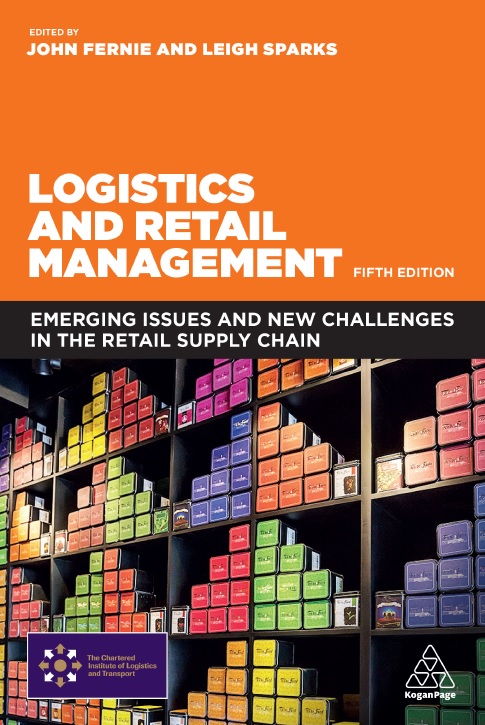By John Fernie and Leigh Sparks

CONTENTS
List of tables xi
Contributors xiii
Preface xvii
01 Retail logistics: Changes and challenges 1
John Fernie and Leigh Sparks
The logistics task 4
Retail logistics and supply chain transformation 8
Supply chain management 10
The grocery retail supply chain in the United Kingdom 17
Supply chain challenges 20
Conclusions 27
References 31
02 Relationships in the supply chain 35
John Fernie
Introduction 35
Power in buyer–seller relationships 36
Quick response 40
Efficient consumer response 44
The role of logistics service providers 52
Conclusions 57
References 58
03 The internationalization of the retail supply chain 65
John Fernie
International sourcing 67
Offshore sourcing and reshoring? 75
Differences in distribution ‘culture’ in international markets 81
The internationalization of logistics practices 86
Conclusions 90
References 91
04 Exploring the international fashion supply chain and
corporate social responsibility: Cost, responsiveness and
ethical implications 97
Patsy Perry and Steve Wood
Introduction 97
The internationalization of the fashion supply chain 99
Ethics and corporate social responsibility in global fashion
supply chains 111
Conclusions 117
References 118
05 The footwear supply chain: The case of Schuh 129
John Fernie and Colin Temple
Introduction 129
The complexity of the footwear supply chain 131
Offshore sourcing, reshoring and outsourcing 135
The case of Schuh 139
Conclusions 145
References 146
06 Luxury fashion supply chain management 149
John Fernie and Patsy Perry
Introduction 149
Definitions of luxury and luxury branding 150
The ‘new’ luxury 155
The evolution of the luxury brand 156
Gaining control of marketing channels 160
Supply chain management in luxury fashion 167
CSR and luxury fashion brands 171
Conclusions 176
References 177
07 Tesco’s supply chain management 183
Leigh Sparks
Introduction 183
The changing Tesco supply chain: establishing control
and delivering efficiency 185
Coping with complexity 200
Conclusions, lessons and challenges 213
References 215
08 Availability in retailing: On-shelf in-store and online
fulfillment 221
David Grant and John Fernie
Introduction 221
Availability on-shelf in-store 221
Availability through online fulfilment 231
Service failure and recovery 234
Conclusions 239
References 240
09 The development of e-tail logistics 245
John Fernie, Suzanne Fernie and Alan McKinnon
Introduction 245
The growth and development of the e/m-commerce
market 246
Web 2.0 252
Exploiting the long tail 253
Online shopping formats 256
The e-commerce consumer 257
The logistical challenges 260
Distribution of online grocery products 262
Distribution of online purchases of non-food items 267
Conclusions 275
References 276
10 Improving the environmental performance of retail
logistics 279
Alan McKinnon
Introduction 279
The environmental effects of retail logistics 280
Restructuring the retail logistics system 283
Shifting freight to greener transport modes 285
Improving vehicle utilization 288
Improving the energy efficiency of retail deliveries 291
Using alternative fuels 292
Topical issues 294
Conclusions 297
References 298
Index 303
PREFACE
At the beginning of each recent edition of this book we have commented on the difficulties of convincing students of the changes that have occurred in the retail supply chain over the last four decades, and yet how many challenges remain. Indeed, as we sign off one edition we think to ourselves that perhaps there will be less change in the next five years. How wrong can we be! It can be argued, however, that in some periods there has been a step change in how goods are delivered to customers. The first step change was the initial shift from a supplier- to a retailer-controlled supply chain. For a long time, the supply of products into retail outlets was controlled by manufacturers and was very much a hit-or-miss affair. Consumers had to put up with the product they found (or did not find) on the shelves, and retailers and manufacturers operated in something of an efficiency vacuum. This situation has now been transformed. Retailers have recognized the need to have more involvement in supply chains and noted that benefits can be achieved in both service levels and cost reduction. Massive efforts have been made to reorganize and reprioritize activities in moving products from production to consumption.
Until the 2000s this shift to retail-controlled supply chains saw incremental change but in the last 5–10 years another step change has occurred. After a slow start, the digital revolution gathered pace and retailers have had to respond to online savvy customers who want to shop and return goods at any time and any place. The omnichannel approach to serving the customer was the key to success. This edition will bring the reader up to date with new issues that have emerged, such as this, and the challenges that remain. But first, a bit of history.
In 1990 John Fernie edited Retail Distribution Management for Kogan Page. This volume, one of the first to look explicitly at distribution (as it then was) in retailing, combined retail academic and practitioner studies and viewpoints to provide a glimpse into what was the first step change in supplying product to stores. It was a fastchanging situation. This volume pointed to a revolution in logistical support to retail stores over the 1980s in the UK. Through academic work and practitioner-written case examples the volume showed how retailers were gaining control of supply chains and reorganizing their own operations, and those of manufacturers, suppliers and distribution specialists, to transform the flow of goods and information in supply chains. In the process, new forms of working using new technologies were improving the quality of products moving through the system, both in physical terms and in terms of time appropriateness. Through the building of relationships with supply partners, efficiency and effectiveness were introduced into previously inefficient and ineffective supply systems. From a concentration on functional silos in physical distribution and materials management, the logistics concept and a focus on end-to-end supply chains was developed. It is interesting to note that most of the names of the companies cited then have disappeared from the high street. The exceptions are J Sainsbury and Grattan (the latter now part of the German Otto Group).
